|
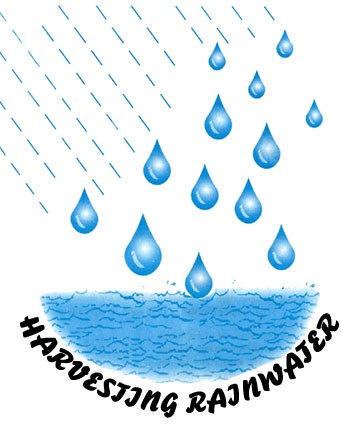

|
In the present scenario management and
distribution of water has become centralized. People depend on government
system, which has resulted in disruption of community participation in water
management and collapse of traditional water harvesting system.
As the water crisis continues to become severe, there is a
dire need of reform in water management system and revival of traditional
systems. Scientific and technological studies needs to be carried out to assess
present status so as to suggest suitable mitigative measures for the revival to
traditional system/wisdom. Revival process should necessarily be backed by
people's initiative and active public participation.
Living creatures of the universe are made of five basic elements,
viz., Earth, Water, Fire, Air and Sky, Obviously, water is one of the most
important elements and no creature can survive without it. Despite having a
great regard for water, we seem to have failed to address this sector seriously.
Human being could not save and conserve water and it sources, probably because
of its availability in abundance. But this irresponsible attitude resulted in
deterioration of water bodies with respect to quantity and quality both. Now,
situation has arrived when even a single drop of water matters. However. "
better late than never", we have not realized the seriousness of this issue and
initiated efforts to overcome those problems.
|
|

|
|
System of collection rainwater and conserving for future needs has
traditionally been practiced in India. The traditional systems were time-tested
wisdom of not only appropriate technology of Rainwater Harvesting, but
also water management systems, where conservation of water was the prime
concern. Traditional water harvesting systems were Bawaries, step wells,
jhiries, lakes, tanks etc. These were the water storage bodies to domestic and
irrigation demands. People were themselves responsible for maintenance to water
sources and optimal use of water that could fulfill their needs.
|
|
What
is Rainwater harvesting?
The
term rainwater harvesting is being frequently used these days, however, the
concept of water harvesting is not new for India. Water harvesting techniques
had been evolved and developed centuries ago.
Ground
water resource gets naturally recharged through percolation. But due to
indiscriminate development and rapid urbainzation, exposed surface for soil has
been reduced drastically with resultant reduction in percolation of rainwater,
thereby depleting ground water resource. Rainwater harvesting is the process of
augmenting the natural filtration of rainwater in to the underground formation
by some artificial methods. "Conscious collection and storage of rainwater to
cater to demands of water, for drinking, domestic purpose & irrigation is termed
as Rainwater Harvesting."
|
|
Why
harvest rainwater ?
This
is perhaps one of the most frequently asked question, as to why one should
harvest rainwater. There are many reasons but following are some of the
important ones.
-
To
arrest ground water decline and augment ground water table
-
To
beneficiate water quality in aquifers
-
To
conserve surface water runoff during monsoon
-
To
reduce soil erosion
-
To
inculcate a culture of water conservation
How
to harvest rainwater:
Broadly there are two ways of harvesting rainwater:
(i)
Surface runoff harvesting
(ii)
Roof top rainwater harvesting
Surface runoff harvesting:
In urban area rainwater
flows away as surface runoff. This runoff could be caught and used for
recharging aquifers by adopting appropriate methods.
Roof
top rainwater harvesting (RTRWH):
It is a system of catching rainwater where it
falls. In rooftop harvesting, the roof becomes the catchments, and the rainwater
is collected from the roof of the house/building. It can either be stored in a
tank or diverted to artificial recharge system. This method is less expensive
and very effective and if implemented properly helps in augmenting the ground
water level of the area.
|
|
Components of the roof top rainwater harvesting system
The
illustrative design of the basic components of roof top rainwater harvesting
system is given in the following typical schematic diagram/
The
system mainly constitutes of following sub components:
§ Catchment
§ Transportation
§ First flush
§ Filter
The surface that
receives rainfall directly is the catchment of rainwater harvesting system. It
may be terrace, courtyard, or paved or unpaved open ground. The terrace may be
flat RCC/stone roof or sloping roof. Therefore the catchment is the area, which
actually contributes rainwater to the harvesting system.
|
|
Transportation
Rainwater from rooftop should be carried through down take water pipes or drains
to storage/harvesting system. Water pipes should be UV resistant (ISI HDPE/PVC
pipes) of required capacity. Water from sloping roofs could be caught through
gutters and down take pipe. At terraces, mouth of the each drain should have
wire mesh to restrict floating material.
First
Flush
First
flush is a device used to flush off the water received in first shower. The
first shower of rains needs to be flushed-off to avoid contaminating
storable/rechargeable water by the probable contaminants of the atmosphere and
the catchment roof. It will also help in cleaning of silt and other material
deposited on roof during dry seasons Provisions of first rain separator should
be made at outlet of each drainpipe.
|
|
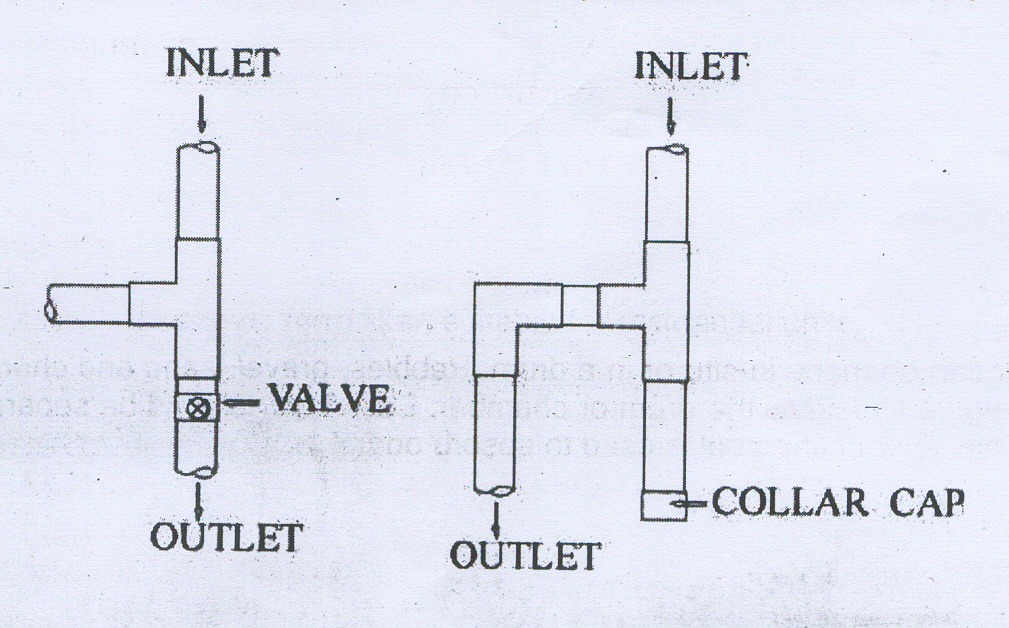
|
|
Filter
There
is always some skepticism regarding Roof Top Rainwater Harvesting since doubts
are raised that rainwater may contaminate groundwater. There is remote
possibility of this fear coming true if proper filter mechanism is not adopted.
Secondly all care must be taken to see that underground sewer drains are not
punctured and no leakage is taking place in close vicinity. Filters are used fro
treatment of water to effectively remove turbidity, colour and microorganisms.
After first flushing of rainfall, water should pass through filters. There are
different types of filters in practice, but basic function is to purify water.
|
|
Sand Gravel Filter
These are commonly used filters, constructed by brick masonry and
filleted by pebbles, gravel, and sand as shown in the figure. Each layer should
be separated by wire mesh.
|
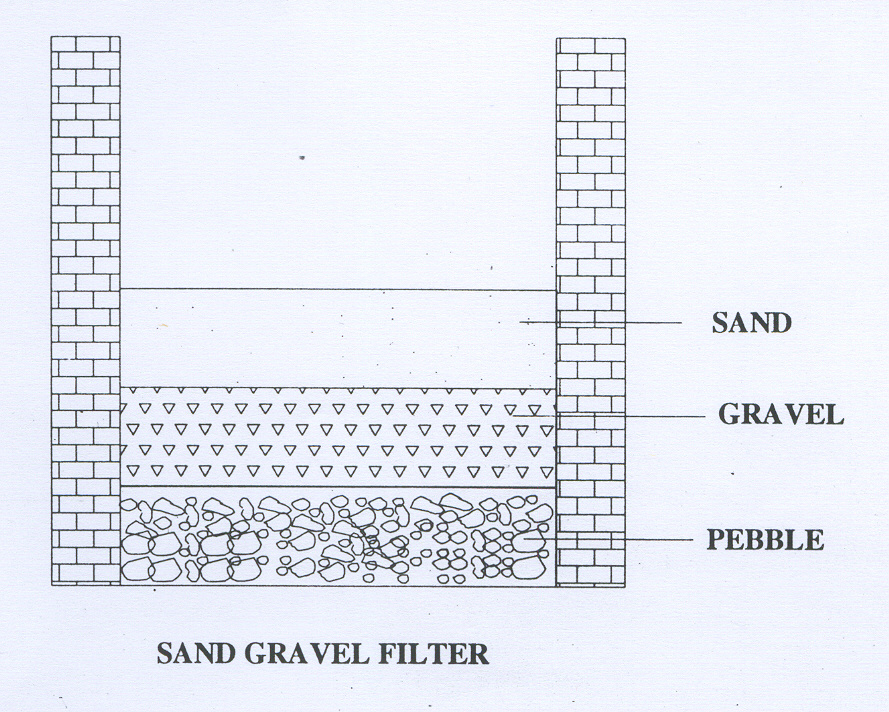
|
|
Charcoal Filter
Charcoal filter can be made in-situ or in a drum. Pebbles, gravel, sand and
charcoal as shown in the figure should fill the drum or chamber. Each layer
should be separated by wire mesh. Thin layer of charcoal is used to absorb odor
if any.
|
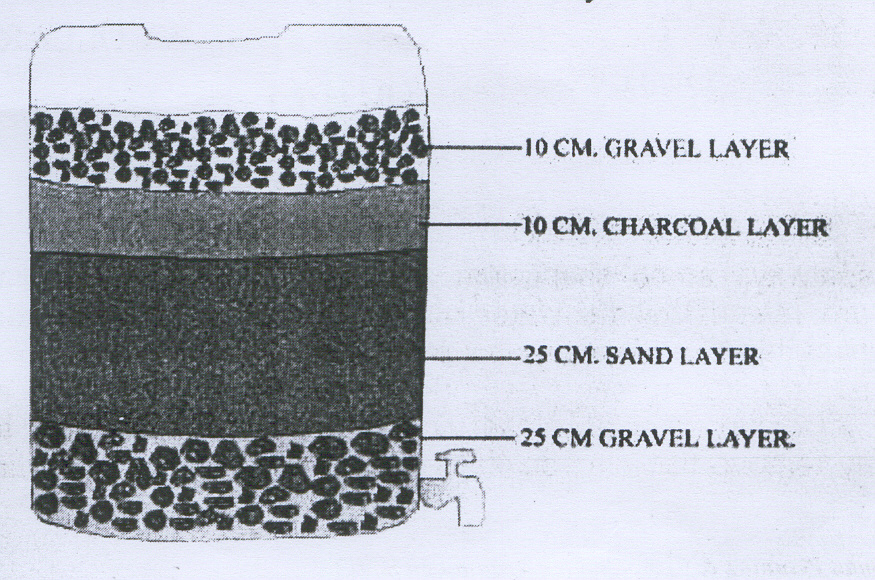
|
|
PVC-
Pipe filter
This
filter can be made by PVC pipe of 1 to 1.20 m length; Diameter of pipe depends
on the area of roof. Six inches dia. pipe is enough for a 1500 Sq. Ft. roof and
8 inches dia. pipe should be used for roofs more then 1500 Sq. Ft. Pipe is
divided into three compartments by wire mesh. Each component should be filled
with gravel and sand alternatively as shown in the figure. A layer of charcoal
could also be inserted between two layers. Both ends of filter should have
reduce of required size to connect inlet and outlet. This filter could be placed
horizontally or vertically in the system.
|

|
|
Sponge Filter
It is
a simple filter made from PVC drum having a layer of sponge in the middle of
drum. It is the easiest and cheapest form filter, suitable for residential
units.
|

|
|
Methods
of Roof Top Rainwater Harvesting
Storage of Direct use
In this method rain water
collected from the roof of the building is diverted to a storage tank. The
storage tank has to be designed according to the water requirements, rainfall
and catchment availability. Each drainpipe should have mesh filter at mouth and
first flush device followed by filtration system before connecting to the
storage tank. It is advisable that each tank should have excess water over flow
system.
Excess water could be
diverted to recharge system. Water from storage tank can be used for secondary
purposes such as washing and gardening etc. This is the most cost effective way
of rainwater harvesting. The main advantage of collecting and using the
rainwater during rainy season is not only to save water from conventional
sources, but also to save energy incurred on transportation and distribution of
water at the doorstep. This also conserve groundwater, if it is being extracted
to meet the demand when rains are on.
Recharging ground water aquifers
Ground
water aquifers can be recharged by various kinds of structures to ensure
percolation of rainwater in the ground instead of draining away from the
surface. Commonly used recharging methods are:-
a)
Recharging of bore wells
b)
Recharging of dug wells.
c)
Recharge pits
d)
Recharge Trenches
e)
Soak ways or Recharge Shafts
f)
Percolation Tanks
Recharging of bore wells
Rainwater collected from rooftop of the building is diverted through drainpipes
to settlement or filtration tank. After settlement filtered water is diverted to
bore wells to recharge deep aquifers. Abandoned bore wells can also be used for
recharge.
Optimum capacity of settlement tank/filtration tank can be designed on the basis
of area of catchement, intensity of rainfall and recharge rate as discussed in
design parameters. While recharging, entry of floating matter and silt should be
restricted because it may clog the recharge structure. "first one or two shower
should be flushed out through rain separator to avoid contamination. This
is very important, and all care should be taken to ensure that this has been
done."
|
|

|
|
Recharge Pits
Recharge pits are small pits of any shape rectangular, square or circular,
contracted with brick or stone masonry wall with weep hole at regular intervals.
to of pit can be covered with perforated covers. Bottom of pit should be filled
with filter media.
The
capacity of the pit can be designed on the basis of catchment area, rainfall
intensity and recharge rate of soil. Usually the dimensions of the pit may be of
1 to 2 m width and 2 to 3 m deep depending on the depth of pervious strata.
These pits are suitable for recharging of shallow aquifers, and small houses.
|
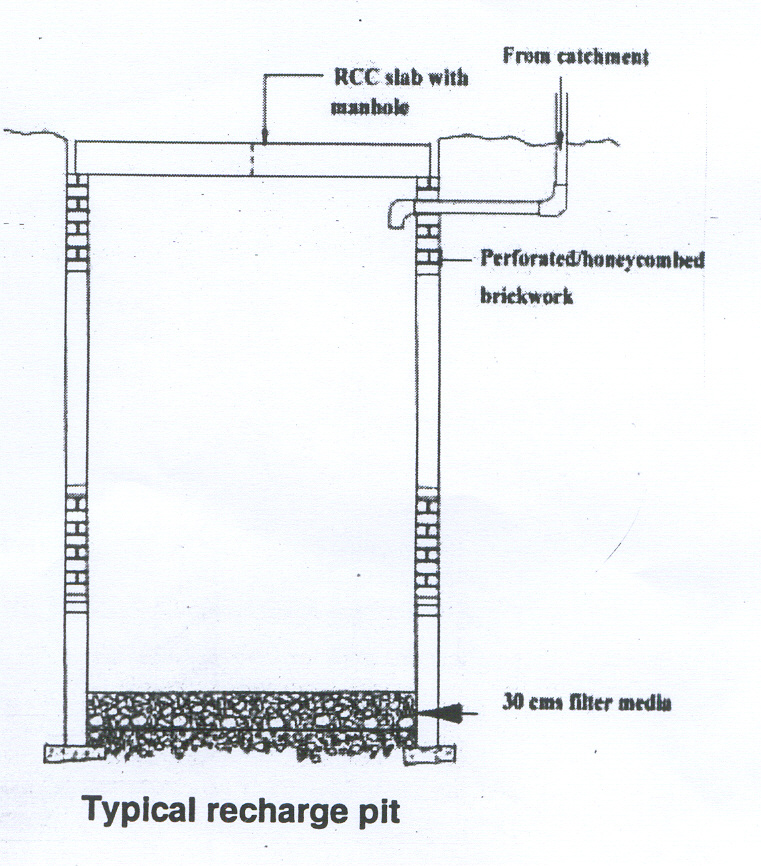
|
|
Soak
away or Recharge Shafts
Soak
away or recharge shafts are provided where upper layer of soil is alluvial
or less pervious. These are bored hole of 30 cm dia. up to 10 to 15 m deep,
depending on depth of pervious layer. Bore should be lined with
slotted/perforated PVC/MS pipe to prevent collapse of the vertical sides. At the
top of soak away required size sump is constructed to retain runoff before the
filters through soak away. Sump should be filled with filter media.
|
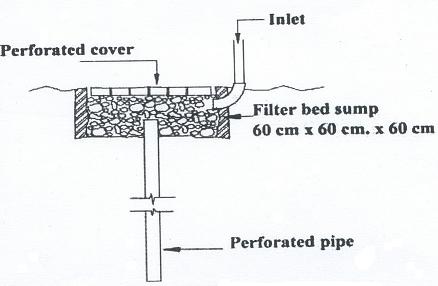
|
|
Recharging of dug wells
Dug
well can be used as recharge structure. Rainwater from the rooftop is diverted
to dug wells after passing it through filtration bed. Cleaning and desalting of
dug well should be done regularly to enhance the recharge rate. The
filtration method suggested for bore well recharging could be used.
|
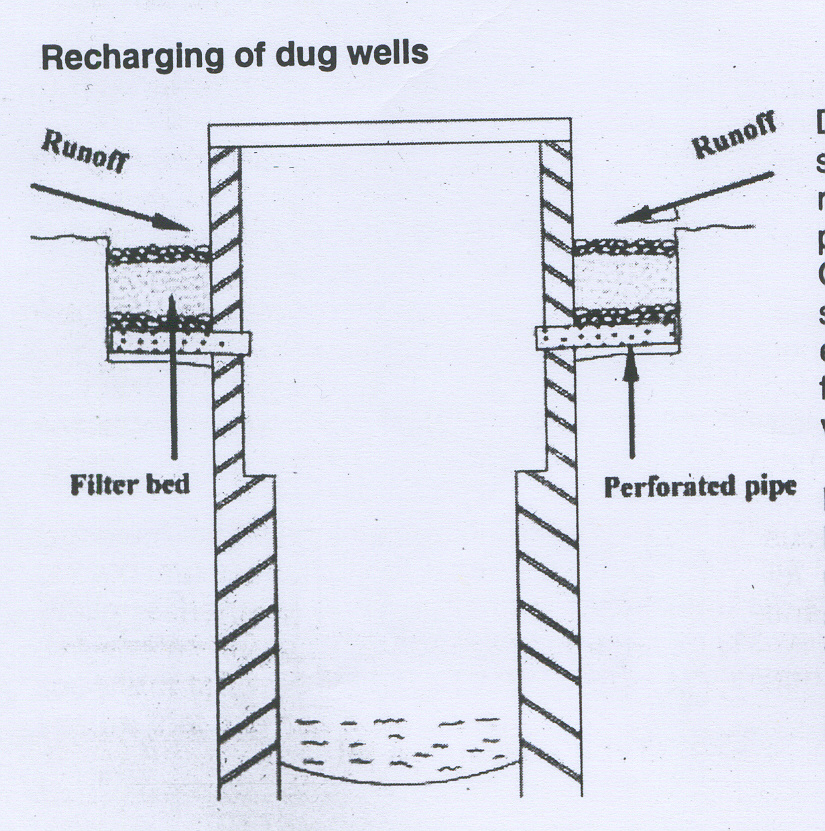
|
|
Recharge Trenches
Recharge trench in provided where upper impervious layer of soil is
shallow. It is a trench excavated on the ground and refilled with porous media
like pebbles, boulder or brickbats. it is usually made for harvesting the
surface runoff. Bore wells can also be provided inside the trench as recharge
shafts to enhance percolation. The length of the trench is decided as per the
amount of runoff expected. This method is suitable for small houses,
playgrounds, parks and roadside drains. The recharge trench can be of size 0.50
to 1.0 m wide and 1.0 to 1.5 m deep.
|
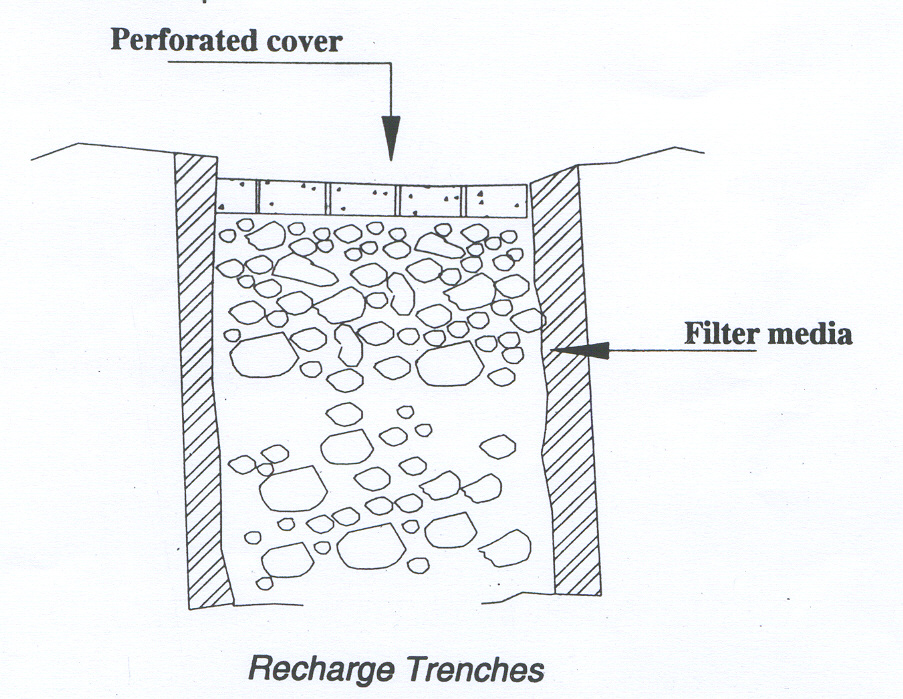
|
|
Percolation tanks
Percolation tanks are artificially created surface water bodies, submerging a
land area with adequate permeability to facilitate sufficient percolation to
recharge the ground water. These can be built in big campuses where land is
available and topography is suitable.
Surface run-off and roof top water can be diverted to this tank. Water
accumulating in the tank percolates in the solid to augment the ground water.
The stored water can be used directly for gardening and raw use. Percolation
tanks should be built in gardens, open spaces and roadside green belts of urban
area.
Do's and Don’ts
Harvested rainwater is used for direct usage
or for recharging aquifers. It is most important to ensure that the rainwater
caught is free from pollutants. Following precautionary measures should be taken
while harvesting rainwater:-
-
Roof or terraces uses for harvesting should be
clean, free from dust, algal plants etc.
-
Roof should not be painted since most paints
contain toxic substances and may peel off.
-
Do not store chemicals, rusting iron, manure
or detergent on the roof.
-
Nesting of birds on the roof should be
prevented.
-
Terraces should not be used for toilets either
by human beings or by pets.
-
Provide gratings at mouth of each drainpipe on
terraces to trap leaves debris and floating materials.
-
Provision of first rain separator should be
made to flush off first rains.
-
Do not use polluted water to recharge ground
water.
-
Ground water should only be recharged by
rainwater.
-
Before recharging, suitable arrangements of
filtering should be provided.
-
Filter media should be cleaned before every
monsoon season.
-
During rainy season, the whole system (roof
catchment, pipes, screens, first flush, filters, tanks) should be checked before
and after each rain and preferably cleaned after every dry period exceeding a
month.
-
At the end of the dry season and just before
the first shower of rain is anticipated, the storage tank should be scrubbed and
flushed off all sediments and debris.
|
|
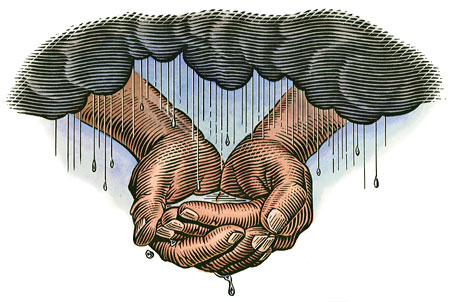
|